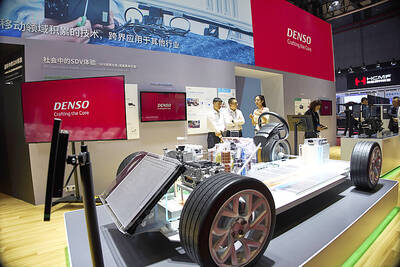Evergreen Group (長榮集團) yesterday said it planned to charter 11 new vessels with capacities of 18,000 twenty-foot equivalent units (TEU) for the use of Evergreen Marine Corp (長榮海運) and its subsidiaries, aiming to upgrade its fleet to lower unit costs.
Evergreen Marine, the nation’s largest container shipper in terms of fleet size, is scheduled to take delivery of the 11 ships from 2018 through 2019, the company said in a statement.
The group has signed a charter agreement with Japan’s Shoei Kisen Kaisha Ltd, with the 11 chartered vessels including the six announced by Evergreen Marine in December last year.
“The group has taken this investment decision to introduce 18,000-TEU vessels based on market demand and the capacity requirement for joint service,” the statement said.
Current service cooperation arrangements with its alliance partners will enable Evergreen Marine to efficiently utilize the capacity and garner the potential economic benefits represented by larger vessels, the company added.
The new ships’ main engine is developed with a longer stroke to operate at lower speeds capable of reducing fuel consumption and greenhouse gas emission up to 7 percent more than traditional main engines, which might help lower the company’s unit cost.
Evergreen Marine’s move is part of its fleet renewal plan, along with the ongoing delivery of its own 30 8,500-TEU L-type vessels, a program beginning in July 2012 that is due to be completed this year.
In addition, Evergreen Marine has already taken delivery of five 8,800-TEU and 10 13,800-TEU chartered ships, with another 10 chartered 14,000-TEU units to be delivered from next year through 2017.

GROWING OWINGS: While Luxembourg and China swapped the top three spots, the US continued to be the largest exposure for Taiwan for the 41st consecutive quarter The US remained the largest debtor nation to Taiwan’s banking sector for the 41st consecutive quarter at the end of September, after local banks’ exposure to the US market rose more than 2 percent from three months earlier, the central bank said. Exposure to the US increased to US$198.896 billion, up US$4.026 billion, or 2.07 percent, from US$194.87 billion in the previous quarter, data released by the central bank showed on Friday. Of the increase, about US$1.4 billion came from banks’ investments in securitized products and interbank loans in the US, while another US$2.6 billion stemmed from trust assets, including mutual funds,

AI TALENT: No financial details were released about the deal, in which top Groq executives, including its CEO, would join Nvidia to help advance the technology Nvidia Corp has agreed to a licensing deal with artificial intelligence (AI) start-up Groq, furthering its investments in companies connected to the AI boom and gaining the right to add a new type of technology to its products. The world’s largest publicly traded company has paid for the right to use Groq’s technology and is to integrate its chip design into future products. Some of the start-up’s executives are leaving to join Nvidia to help with that effort, the companies said. Groq would continue as an independent company with a new chief executive, it said on Wednesday in a post on its Web

JOINT EFFORTS: MediaTek would partner with Denso to develop custom chips to support the car-part specialist company’s driver-assist systems in an expanding market MediaTek Inc (聯發科), the world’s largest mobile phone chip designer, yesterday said it is working closely with Japan’s Denso Corp to build a custom automotive system-on-chip (SoC) solution tailored for advanced driver-assistance systems and cockpit systems, adding another customer to its new application-specific IC (ASIC) business. This effort merges Denso’s automotive-grade safety expertise and deep vehicle integration with MediaTek’s technologies cultivated through the development of Media- Tek’s Dimensity AX, leveraging efficient, high-performance SoCs and artificial intelligence (AI) capabilities to offer a scalable, production-ready platform for next-generation driver assistance, the company said in a statement yesterday. “Through this collaboration, we are bringing two

Even as the US is embarked on a bitter rivalry with China over the deployment of artificial intelligence (AI), Chinese technology is quietly making inroads into the US market. Despite considerable geopolitical tensions, Chinese open-source AI models are winning over a growing number of programmers and companies in the US. These are different from the closed generative AI models that have become household names — ChatGPT-maker OpenAI or Google’s Gemini — whose inner workings are fiercely protected. In contrast, “open” models offered by many Chinese rivals, from Alibaba (阿里巴巴) to DeepSeek (深度求索), allow programmers to customize parts of the software to suit their